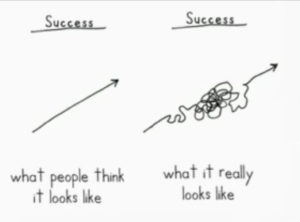Punctuated Equilibrium is a theory in evolutionary biology that seems to fit well with progress in students’ learning.
What is Punctuated Equilibrium
Punctuated Equilibrium was first proposed in the 1970s by Nile’s Elderedge and Stephen Jay Gould. They argued that while most of us think that evolution happens gradually, the fossil record showed evolution happens in spurts. Stasis (or equilibrium) is the norm, then there are bursts of activity (the equilibrium is punctured) and then stasis reigns again.
There is a helpful post here explaining it in more detail but the difference between gradualism and punctuated equilibrium can be shown as per the below

As a model, it has been attacked by Dawkins and Bennett. They called Punctuated Equilibrium “evolution by jerks” (to which Stephen Jay Gould’s response was that Gradualism was “evolution by creeps”).
That said, the punctuated equilibrium dynamic seems to happen outside of the natural world too. In industry, there is often stasis, then a new environment (often triggered by an innovation) leads to a burst of new prototypes before these are whittled down to a smaller handful of product categories. Bicycles seem to be a good example of this. As BicycleHistory says:
Between 1817 when Nicéphore Niépce created his first velocipede and 1880 when first “safety bicycles” became highly popular across Europe, bicycle designs were highly varied

It seems is might be a useful lens through which to assess learning too
Punctuated Progress
David Didau has written a number of good posts about the myth of progress. He points out that, as in Hugh Macleod’s Gaping Void Cartoon, while we act like progress is linear, it’s more confusing that that.
It’s a great diagram for pointing out the shortfalls of thinking about progress as linear, but it doesn’t help much in terms of “where next”. I’m curious to know if the punctuated equilibrium model is more helpful.
There are some obvious ones such as that if progress is characterised by periods of stasis, then there will be lessons in which students are not performing substantially differently. Threshold concepts look to be a tidy fit with the model and I’m going to have a further read to see how these might help. If anyone has any pointers, I’d love to hear.
